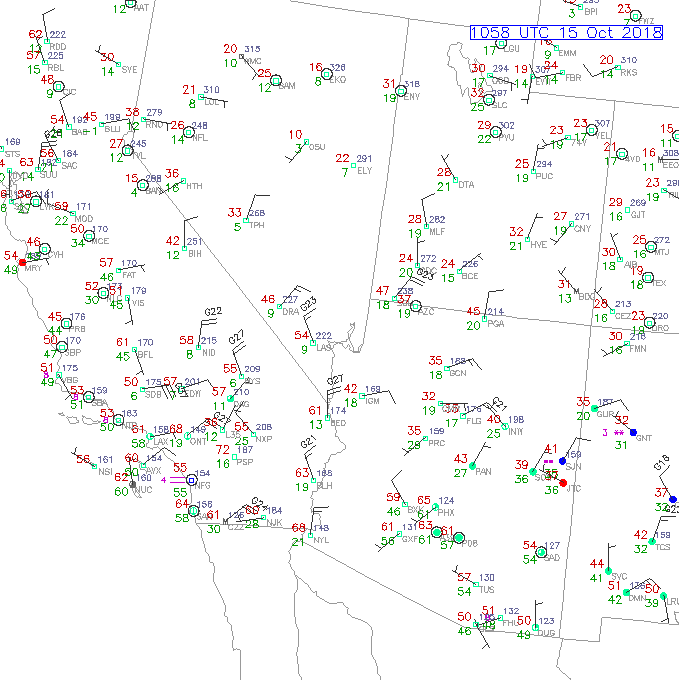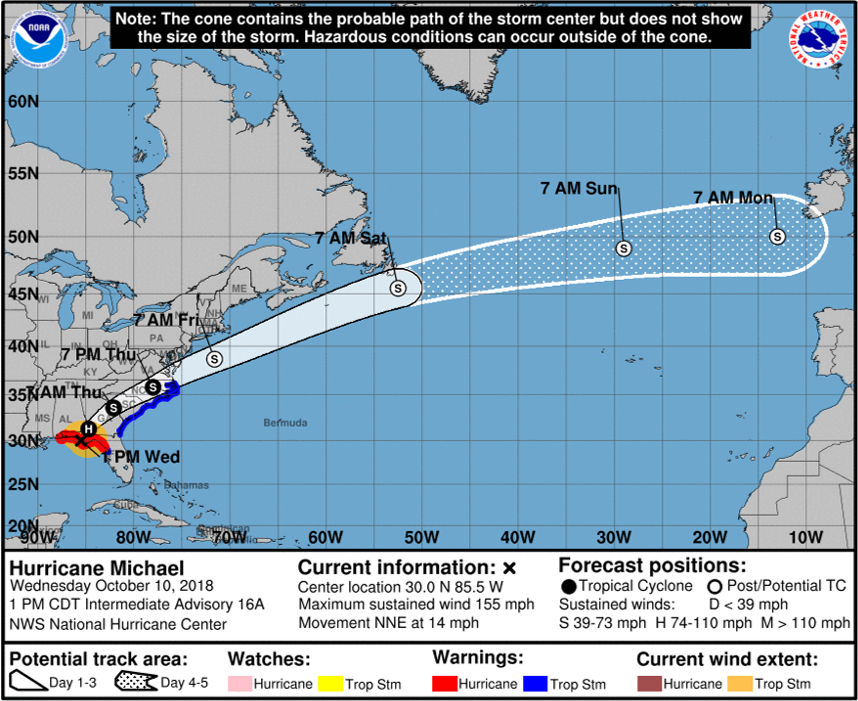DNB: Ship Light Monitoring and Sea Ice Motion
October 31st, 2018 by Jorel TorresThe Day/Night Band (DNB) utilizes a sun/moon reflectance model that illuminates atmospheric features, and senses emitted and reflected light sources during the nighttime hours. The DNB is at 0.7um and is apart of 22 spectral channels on-board the Suomi National Polar-orbiting Partnership (S-NPP) satellite and the new NOAA-20 satellite.
In the DNB video below (using CIRA POLAR Slider) DNB is monitoring emitted ship lights in the East Siberian Sea, just northwest of Pevek, Russia. Refer to the yellow circle in the video. The ship appears to be moving to the east, traversing through the sea ice, over the course of four hours. Note, during this time period, the sea ice motion is moving to the north as well (i.e. refer to yellow arrow). Emitted town lights near Pevek, Russia and along the coast can be seen in the imagery as well.
For more information on DNB, refer to the following training material.
Posted in: POES, Satellites, | Comments closed
Hurricane Willa
October 23rd, 2018 by Jorel TorresHurricane Willa is forecasted to make landfall, along the coast of Mexico, within the next few hours. Willa, once deemed a Category 5 hurricane, has been downgraded to a Category 3 hurricane within the last 24 hours, with max sustained winds at 125 mph, moving north-northeast at 6 mph according to the National Hurricane Center (NHC) at 9AM MDT. The majority of people that reside in Willa’s path have been ordered to evacuate, with high winds, copious precipitation, storm surge and flooding to be expected. Below, geostationary and polar-orbiting satellites observed the event, where satellite imagery can be inspected below.
Advected Layered Precipitable Water (ALPW): 1800-1200Z, 22-23 October 2018
ALPW measures Precipitable Water (PW) values within four layers of the atmosphere (i.e. surface-850mb, 850-700mb, 700-500mb, 500-300mb) to identify where the majority of PW is concentrated (i.e. usually within the first 3 kilometers above the surface). For simplicity, the ALPW surface-850mb layer video is shown below, showing the location of Hurricane Willa, as it approaches the Mexican coast. Note, ALPW utilizes GFS model winds in the algorithm, and is updated every 6 hours. The modeled product shows the hurricane’s forecasted track yesterday, through this morning, 23 October 2018. High PW values are shown in red, where black pixels within the hurricane, denote precipitating regions. Microwave products such as ALPW, cannot retrieve data samples within areas of precipitating regions (i.e. displayed areas of missing data), however retrievals can sample within cloudy regions.
GOES-16 10.3um: 1450-1600Z, 23 October 2018
Infrared imagery, at a high temporal resolution (i.e. in this case, every 5 minutes) shows the magnitude of the Willa as the eyewall begins to traverse the Islas Marias then move toward the Mexican coast. Deep convection (i.e. regions of heavy precipitation) denoted in dark red-to-black colors, is spotted predominately to the north and west of the eyewall.
For the latest updates on Hurricane Willa, click on the following link.
Posted in: Tropical Cyclones, | Comments closed
Santa Ana Winds and Dust Identification
October 16th, 2018 by Jorel TorresIt is that time of year again, to observe Santa Ana Wind events for Southern California. On 15 October 2018, an upper-level trough advected into the southwestern United States (i.e. see GOES-16, Upper Level Water Vapor imagery below), produced cold air advection aloft, and brought strong subsidence (i.e. sinking motion) to the surface. The strong subsidence, brought cold, dry, and fast, downsloping winds along the Sierras, towards the coastline. The downsloping winds produced compressional warming, a process that warms the surface air tens of degrees fahrenheit over a short period of time. The following satellite imagery and surface observations of the event are taken between 9-20Z, 15 October 2018.
GOES-16 -> Upper Level Water Vapor (6.2um) : 12-20Z, 15 October 2018
Surface Wind Observations: 10-20Z, 15 October 2018
Note the strong, northeasterly winds in Southern California, with wind gusts over 40 mph. Additionally, notice rapid warming of air temperatures along with a significant decrease in dewpoint temperatures, especially along the coast.

GOES-16 -> Low Level Water Vapor (7.3um): 17-20Z, 15 October 2018
A rapid warming of Brightness Temperatures (BT), represented by pink and yellow colors, advects from northeast-to-southwest bringing warm, dry air to the Los Angeles Metropolitan area. Note, the wave-like patterns produced off of the Sierras create turbulence in the boundary layer, and are hazards for the aviation industry.
Microwave Sensors -> CIRA Advected Layered Precipitable Water (CIRA-ALPW): 9-18Z, 15 October 2018
Another way to see how dry the surface air is, one can use the CIRA-ALPW product, comprised of microwave data. CIRA-ALPW estimates the precipitable water (i.e. moisture content) within a vertical column of the atmosphere. Unlike other precipitable water products, CIRA-ALPW produces precipitable water values within four layers of the atmosphere (i.e. surface-850mb, 850-700, 700-500 and 500-300mb) and utilizes GFS model winds in the algorithm. In the following CIRA-ALPW, surface-to-850mb video, see the moisture gradient, and dry air (i.e. low TPW values) shift southwestward, towards the coastline.
GOES-16 -> Split-Window Difference (10.3um-12.3um): 17-20Z, 15 October 2018
The Split-Window Difference product shows areas of dust, produced by the high winds, seen within the black ellipses. Regions of low-level dust are denoted as negative values, and represented by dark brown signatures. The Split Window Difference product identifies these areas as dust, due to the 10.3um Brightness Temperature (BT) is colder than the 12.3um BT; where silicates in dust are absorbed in 10.3um.
GOES-16 -> GeoColor: 17-20Z, 15 October 2018
In complement to the Split Window Difference product, one can use the GeoColor product to identify dust within the black ellipses. Play the following video. Notice dust over land may not be as discernible to dust advecting over bodies of water. If one is still having trouble identifying dust, focus on the following cities: Long Beach, Mission Viejo, Oceanside, Temecula, the Salton Sea, Ocotillo, and Barstow.
Posted in: Dust, | Comments closed
Hurricane Michael
October 10th, 2018 by Jorel TorresHurricane Michael has made landfall today, along the Florida Panhandle, between Tyndall Air Force Base, FL and Mexico Beach, Florida. Radar and satellite products observed Michael, as it approached the Florida Panhandle (seen below). Over the last 12 hours, Michael increased in maximum wind speed to 155-mph and had a pressure level of 919-mb.
Radar – Base Reflectivity (Tilt – 0.5 degrees) between 15-17Z, 10 October 2018 (via College of Dupage). Notice the heavy rain bands in the inner and outer core of Hurricane Michael, producing heavy precipitation, and very high wind speeds.
Blended Total Precipitable Water (TPW) at 1456Z, 10 October 2018. A microwave product that estimates TPW throughout the entire column of the atmosphere. Purple and white colors express high moisture content (i.e. high TPW values, ~2.5-3 inches) that Hurricane Michael encapsulates, which can lead to heavy precipitation and flooding.

Advected Layered Precipitable Water (ALPW) from 18Z, 9 October 2018 to 15Z, 10 October 2018. Different from the Blended TPW, ALPW estimates precipitable water values in 4 different layers (i.e. refer to 4-panel below: surface-850mb (top-left), 850-700mb (top-right), 700-500mb (bottom-left), and 500-300mb (bottom-right)), where the majority of moisture content is located in the lower layers of the atmosphere (i.e. within 3-km above the surface). GFS model winds are incorporated into the algorithm. Black pixels in the imagery represent precipitating regions, denoted as ‘missing data’. Although microwave retrievals can be made in cloudy regions, they cannot be made in precipitating regions.
GOES-16, infrared band 13 (10.3 um) at 1634Z, 10 October 2018. Imagery shows Hurricane Michael, on the cusp of landfall, showing a well defined eyewall and cold brightness temperatures (i.e. red to dark-red colors) within the inner and outer core of the hurricane. 
NHC Forecast (below) for the next few days, as of 1 PM CDT update. Hurricane Michael will interact with an upper level trough, and move to the northeast, producing heavy precipitation in Florida, Georgia and the Carolinas. The system will be downgraded to a Tropical Storm by Thursday and will eventually move out to sea, by the weekend.

Posted in: Tropical Cyclones, | Comments closed
The Arizona Hurricane Rosa Heavy Rainfall Event for Late September to Early October 2018
October 5th, 2018 by Dan BikosThis blog entry is by Sheldon Kusselson and in the format of a PDF document:
Hurricane Rosa Event_LateSept_EarlyOct2018
Posted in: Heavy Rain and Flooding Issues, Hydrology, POES, Satellites, | Comments closed
